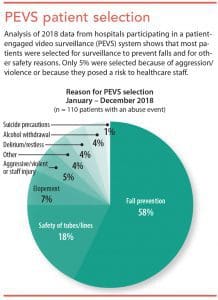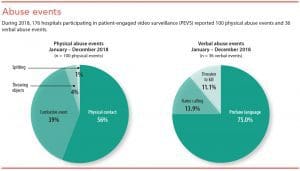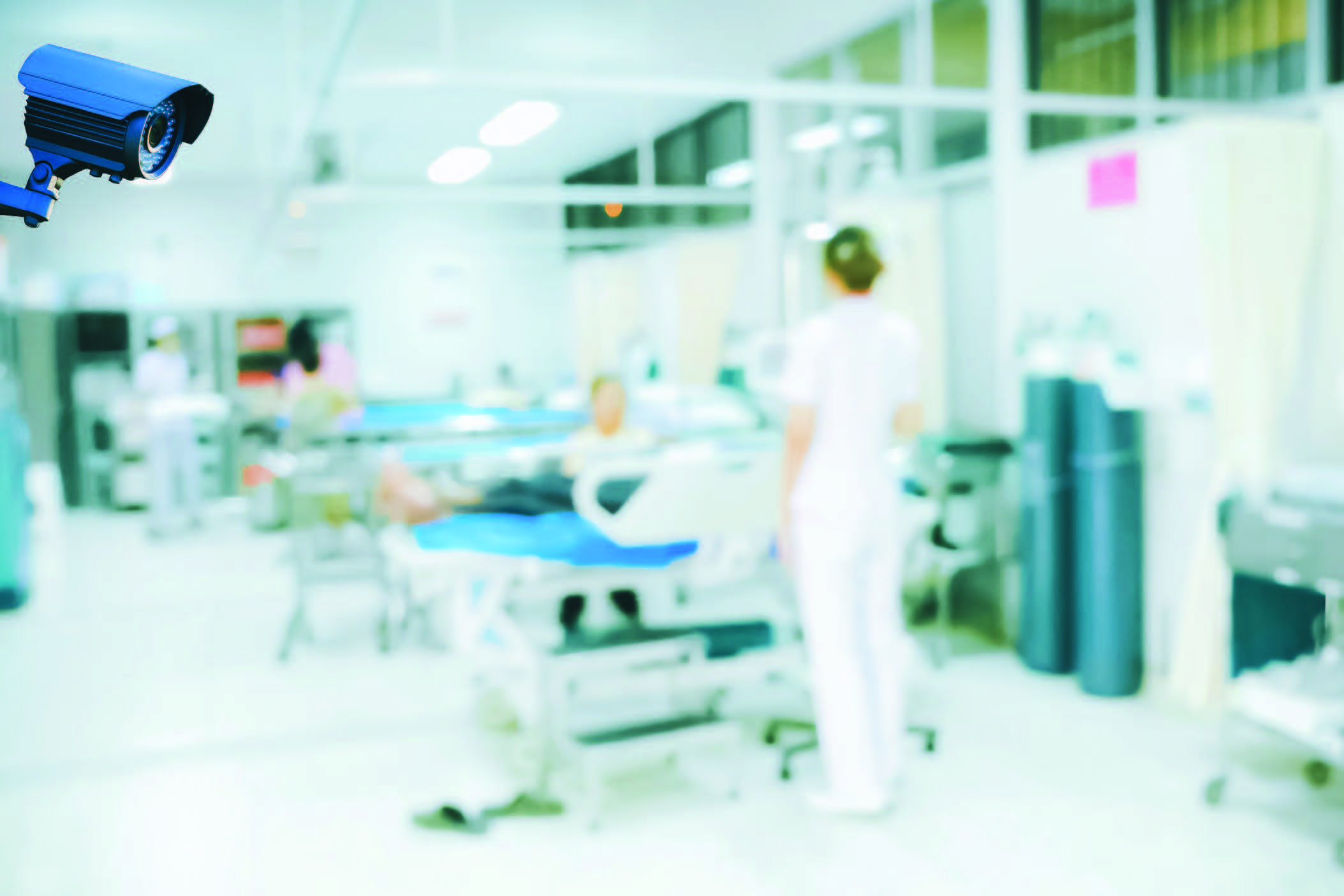This strategy can benefit both nurses and patients.
Takeaways:
- Patient-engaged video surveillance is a reliable method to accurately determine the incidence of patient aggression and violence on the nursing workforce for those under surveillance.
- Trained monitor technicians, who work 24-hours a day, are rapid responders to incidents of aggression and violence, increasing both patient and nursing workforce safety.
- Constant nonintrusive video surveillance, combined with individualized patient interaction, frequently prevents physical aggression and violence.
HEALTHCARE WORKERS are four times more likely to experience workplace violence (defined by the National Institute for Occupational Safety and Health [OSHA] as “the act or threat of violence, ranging from verbal abuse to physical assaults directed toward persons at work or on duty”) than workers in other industries, according to OSHA. However, even after The Joint Commission encouraged healthcare organizations to better track and address the problem, the true incidence of patient-initiated aggression and violence against staff is unknown because it isn’t being carefully followed or consistently reported. Instead, research has relied on survey responses based on nurses’ recollections.
This hole in hospital safety requires a call to action. Patient-engaged video surveillance (PEVS) provides a mechanism to track and report patient aggression and violence against caregivers.
PEVS
PEVS is an interactive form of video surveillance in which dedicated, trained staff use a hospital workstation to monitor multiple patients simultaneously. Through a two-way audio communication system, a staff member communicates with patients and staff and documents adverse events that occur while the patient is under observation. Published research on PEVS outcomes reports an effective reduction in overall falls and falls with- injury rates. These studies also report financial savings via reductions in one-to-one sitter costs. No studies have measured actual prevented and observed patient aggression/violence against healthcare staff; however, evidence of prevented abuse events indicates that as monitoring staff become familiar with patients’ behavioral patterns, they can proactively intervene before behaviors escalate.
Scope of surveillance
In the United States, 176 acute-care and rehabilitation hospitals have implemented a PEVS system (AvaSure®) and subscribed to its database. Between January 1 and December 31, 2018, data were collected from 78,746 patients, totaling 204,588 video-monitoring in-hospital days. In each hospital, primary bedside nurses selected appropriate patients for PEVS based on the nurses’ clinical judgment (with guidance of hospital-specific policies) that the patients were a risk to themselves and/ or staff. After patients were selected, primary bedside nurses explained the PEVS program to them and their families and that it was part of their individualized plan of care. Because the system is for monitoring only (it doesn’t record audio or video) and the monitoring station isn’t visible to the public, written consent wasn’t required. During surveillance, the monitoring staff learned each patient’s behaviors and verbally engaged with him or her to help prevent abuse events. In the case of an urgent or emergent observed behavior, the monitoring staff triggered the PEVS alarm. Monitoring staff reported prevented abuse events and actual abuse events they observed and included brief descriptions.
Data collection
All participating hospitals agreed to analysis and publication of aggregated data. Data from each hospital’s PEVS system were uploaded to a secure database. Raw data (excluding protected health information as defined by the Health Insurance Portability and Accountability Act) from the hospitals’ servers were securely exported monthly. The data were then aggregated to provide program metrics and national comparisons for database subscribers.
Measures chosen for analysis included:
• verbal intervention: talk button used to speak directly to patient
• PEVS alarm: alarm activated by monitoring staff in urgent or emergent situations
• physical abuse event: aggressive behavior that may or may not result in injury to either the patient or the caregiver and reported by monitoring staff
• combative event: behaviors such as flailing, swinging, and attempting to hit, not involving physical contact
• physical contact: behaviors such as hitting, kicking, grabbing, slapping, and biting
• verbal abuse event: abusive or demeaning language
• abuse event avoided: event prevented via verbal intervention or PEVS alarm
The abuse events rate and the abuse events avoided rate were calculated by dividing the number of events by patient days on PEVS and multiplying by 1,000. This rate was chosen for consistency with national standards for reporting falls and falls-with-injury rates per 1,000 patient days.


Actual and prevented abuse events
The most common reason for monitoring patients using PEVS was for fall prevention (58%). (See PEVS patient selection.) From January 1 to December 31, 2018, 136 abuse events (physical abuse, n = 100; verbal abuse, n = 36) were initiated by 110 patients (0.66 adverse abuse events per 1,000 patient days). (See Abuse events.) Most of the verbal abuse involved profanity toward the caregiver. In five cases, the patient threatened to kill the caregiver. In addition, monitoring staff reported preventing 5,458 abuse events. Most (90%) of the prevented events involved verbal intervention; only 10% required a PEVS alarm.
PEVS outcomes and benefits
The outcomes reported for this 1-year analysis confirm the benefits of PEVS technology to patient and nurse workforce safety. Data reveal that as monitoring staff were observing and documenting incidents of physical and verbal abuse, they were able to prevent 40 abuse events for every actual event that occurred.
Studying the outcomes in this patient cohort provides a new window of understanding into the effectiveness of PEVS for preventing patient-initiated abuse. Data suggest that remote verbal interventions (the staff voices behind the camera) are an effective way to prevent violent patient events. However, several areas require additional evaluation. For example, because the same protocol for patient selection wasn’t used at all the hospitals, examining patient selection criteria is difficult. Also, risk-for-violence scales should be incorporated into patient selection criteria, and verbal de-escalation training should be provided for monitoring staff.


Having a remote monitoring staff member report physical and verbal abuse events and prevented abuse events is an important step toward capturing more data to understand assault patterns and implementing appropriate controls to reduce or eliminate their incidence.
Patricia A. Quigley is a nurse consultant with Patricia A. Quigley, Nurses Consultant, LLC in St. Petersburg, Florida, and an independent contractor with AvaSure, LLC in Belmont, Michigan. Lisbeth Votruba is vice president of clinical quality and innovation at AvaSure. Jill Kaminski is a clinical data system analyst at AvaSure. Per American Nurse Today editorial policy, this article underwent peer review, and the reviewers did not find bias.
Selected references
Alyaemni A, Alhudaithi H. Workplace violence against nurses in the emergency departments of three hospitals in Riyadh, Saudi Arabia: A cross-sectional survey. NursingPlus Open. 2016;2:35-41.
American Nurses Association. ANA responds to The Joint Commission Sentinel Event Alert on physical and verbal violence against health care workers. April 18, 2018. nursingworld.org/news/news-releases/2018/ana-responds-to-the-joint-commission-sentinel-event-alerton-physical-and-verbal-violence-against-health-care-workers
Burtson PL, Vento L. Sitter reduction through mobile video monitoring: A nurse-driven sitter protocol and administrative oversight. J Nurs Adm. 2015;45(7-8):363-9.
Centers for Disease Control and Prevention. The National Institute for Occupational Safety and Health (NIOSH): Occupational violence. 2018. cdc.gov/niosh/topics/violence
Cournan M, Fusco-Gessick B, Wright L. improving patient safety through video monitoring. Rehabil Nurs. 2018;43(2):111-5.
Crilly J, Chaboyer W, Creedy D. Violence towards emergency department nurses by patients. Accid Emerg Nurs. 2004;12(2):67-73.
Gomaa AE, Tapp LC, Luckhaupt SE, et al. Occupational traumatic injuries among workers in health care facilities—United States, 2012–2014. Centers for Disease Control and Prevention. MMWR. 2015;64 (15):405-10. cdc.gov/mmwr/preview/mmwrhtml/mm6415a2.htm
James JT. A new, evidence-based estimate of patient harms associated with hospital care. J Patient Saf. 2013;9(3):122-8.
Jeffers S, Searcey P, Boyle K, et al. Centralized video monitoring for patient safety: A Denver Health Lean journey. Nurs Econ. 2013;31(6):298-306.
The Joint Commission. Sentinel event alert 59. Physical and verbal violence against health care workers. 2018. jointcommission.org/assets/1/18/SEA_59_Workplace_violence_4_13_18_FINAL.pdf
Speroni KG, Fitch T, Dawson E, Dugan L, Atherton M. Incidence and cost of nurse workforce violence perpetrated by hospital patients or patient visitors. J Emerg Nurs. 2014;40(3):218-28.
Votruba L, Graham B, Wisinski J, Sayed A. Video monitoring to reduce falls and patient companion costs. Nurs Econ. 2016;34(4)185-9.
U.S. Department of Health and Human Services. Guidance regarding methods for de-identification of protected health information in accordance with the Health Insurance Portability and Accountability Act (HIPAA) privacy rule. November 6, 2015. hhs.gov/hipaa/for-professionals/privacy/special-topics/de-identification/index.html
Westle MB, Burkert GR, Paulus RA. Reducing inpatient falls and injury rates by integrating new technology with workflow redesign. NEJM Catalyst. May 23, 2019. catalyst.nejm.org/reducing-inpatientfalls-virtual-sitter


















